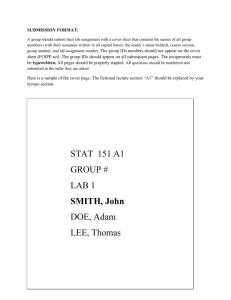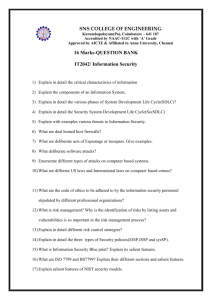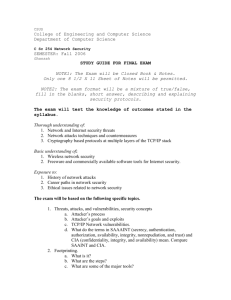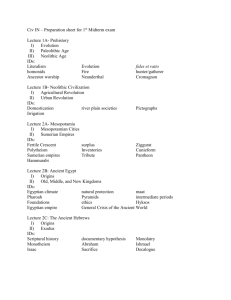ETF Journal korica
advertisement
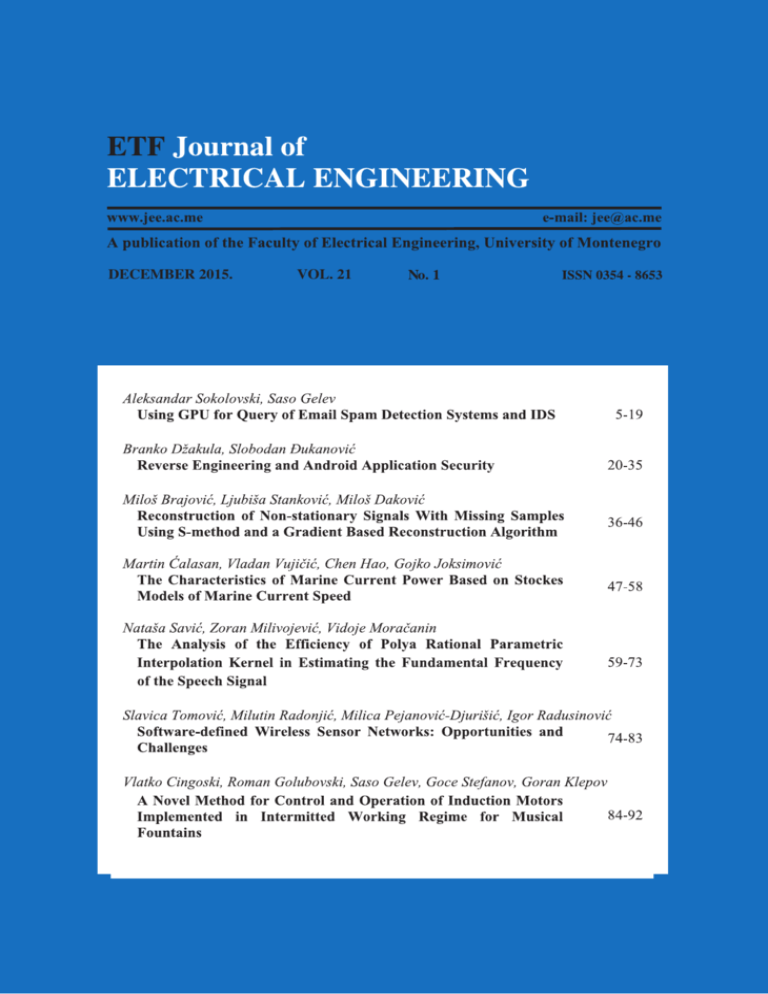
DECEMBER 2015.
VOL. 21
Published by
University of Montenegro
Faculty of Electrical Engineering
Džordža Vašingtona bb.
tel: +382 20/245-839
fax: +382 20/245-873
web: www.jee.ac.me
e-mail: jee@ac.me
Editorial board
Prof. Ljubiša Stanković, PhD, Editor in Chief
Assist. Prof. Milutin Radonjić, PhD
Prof. Božo Krstajić, PhD
Prof. Veselin Ivanović, PhD
Prof. Vladan Vujičić, PhD
Assoc. Prof. Vesna Popović - Bugarin, PhD
Assist. Prof. Vladan Radulović, PhD
Prof. Radovan Stojanović, PhD
Technical support: Željko Vujović
ETF Journal of
ELECTRICAL ENGINEERINGJo
ELECTRICAL ENGINEERING
www.jee.ac.me
e-mail: jee@ac.me
A publication of the Faculty of Electrical Engineering, University of Montenegro
DECEMBER 2015.
VOL. 21
No. 1
ISSN 0354 - 8653
Aleksandar Sokolovski, Saso Gelev
Using GPU for Query of Email Spam Detection Systems and IDS
Branko Džakula, Slobodan Đukanović
Reverse Engineering and Android Application Security
5-19
20-35
Miloš Brajović, Ljubiša Stanković, Miloš Daković
Reconstruction of Non-stationary Signals With Missing Samples
Using S-method and a Gradient Based Reconstruction Algorithm
36-46
Martin Ćalasan, Vladan Vujičić, Chen Hao, Gojko Joksimović
The Characteristics of Marine Current Power Based on Stockes
Models of Marine Current Speed
47-58
Nataša Savić, Zoran Milivojević, Vidoje Moračanin
The Analysis of the Efficiency of Polya Rational Parametric
Interpolation Kernel in Estimating the Fundamental Frequency
of the Speech Signal
59-73
Slavica Tomović, Milutin Radonjić, Milica Pejanović-Djurišić, Igor Radusinović
Software-defined Wireless Sensor Networks: Opportunities and
74-83
Challenges
Vlatko Cingoski, Roman Golubovski, Saso Gelev, Goce Stefanov, Goran Klepov
A Novel Method for Control and Operation of Induction Motors
84-92
Implemented in Intermitted Working Regime for Musical
Fountains
ETF Journal of
ELECTRICAL ENGINEERING
ČASOPIS ZA ELEKTROTEHNIKU
A PUBLICATION OF THE EE DEPARTMENT, UNIVERSITY OF MONTENEGRO
JANUARY 2004.
VOL. 11
No. 1
YU ISSN 0353 - 5207
Zoran Veličković, Zoran Milivojević, Milojko Jevtović
The Improved Iterative Algorithm for the Enhancement of the
Extracted Watermark From Video Streaming in a Wireless
Environment
Stevan Šandi, Tomo Popović, Božo Krstajić
Python Implementation of IEEE C37.118 Communication
Protocol
Žarko Zečević, Zdravko Uskoković, Božo Krstajić
A New Algorithm for Phasor Estimation in Unbalanced ThreePhase Power System
Ana Jovanović, Luka Lazović, Vesna Rubežić
Chaos Theory Implementation on the LMS
Optimization Applied on Linear Antenna Arrays
Algorithm
Novica Daković, Milovan Radulović
Flatness and LQR Control of Furuta Pendulum
LECTURE NOTE:
Ljubiša Stanković, Isidora Stanković
Reconstruction of Sparse and Nonsparse Signals From a Reduced
Set of Samples
93-107
108-117
118-127
128-137
138-146
147-169
USING GPU FOR QUERY OF EMAIL SPAM
DETECTION SYSTEMS AND IDS
Aleksandar Sokolovski , Saso Gelev
Abstract: The scope of this research paper is one very important aspects nowadays,
the security and management of one of the most important services the email and all
of the alike online services today. This paper attempts to investigate the possible
benefits of using standard signature-driven spam detection logic in combination with
algorithm for network intrusion detection system (NIDS). The primary objective is to
verify that proposed solution (standard signature-driven spam detection logic and
NIDS) will be an effective strategy for dealing with email spam detection. The main
aim is to determine best possible integration of standard signature-driven spam
detection logic in combination with algorithm for NIDS, for creating more effective
solution for dealing with email spam and priority mail compared to the previous
solutions available. This will be achieved by testing the effectiveness of the solution
compared to other solutions until today, by using network simulators NS-3 and other
programming tools.
1. INTRODUCTION
The email was one of the most important communication tools and it also is one of
the most important communication tools nowadays. The email is also one of the most used
services on the World Wide Web. According [1] to here are the general data about email:
In 2012 144 billions emails were send per day worldwide
In 2012 there were 2.2 billion email users worldwide.
In 2012 4.3 billion email clients for sending email worldwide
In 2012 and 69% of worldwide email was spam.
In 2011 also 71% of email was email spam.
The importance of fast email delivery has change over the year and from being a
reliable and fast delivery system, it has become an immediate delivery system. Many
enterprises, companies and organization use various techniques and methods for dealing
with spam:
DNS whitelist and blacklists
Load Sharing: Load is shared among several servers using Layer 4 switches or
DNS round-robin.
Aleksandar Sokolovski, Neotel – Macedonia, R&D Department, Skopje, Macedonia
Saso Gelev, Faculty of Electrical engineering, University of Goce Delcev, Stip, Macedonia
6
ETF Journal of Electrical Engineering, Vol. 21, No. 1, December 2015.
DNS Blacklisting: Identify whether the sender is going to send spam or not
according to the sender’s IP address with a help of DNS.
Bayesian spam filtering
Hybrid Filtering
Firewall is hardware or software based network security systems that monitors and
controls inbound and outbound network traffic by analyzing the packets.
The first generation of firewalls only filter packets.
The second generation of firewalls are known as stafefull, they analyze packets like the
first generation (Layer 3 – IP address) but the difference is they operate up to Layer 4
(Ports) of the ISO OSI network model.
The Third generation of firewall are known as application firewall and they work on
Layer 7 (ISO OSI).
An intrusion detection system (IDS) monitors network traffic and monitors for suspicious
activity and alerts the system or network administrator. In some cases the IDS may also
respond to anomalous or malicious traffic by taking action such as blocking the user or
source IP address from accessing the network IDS come in a variety of “flavors” and
approach the goal of detecting suspicious traffic in different ways. There categories are:
NIDS, HIDS, Signature Based, Anomaly Based. [1]
1.1. NIDS
Network Intrusion Detection Systems are placed at a strategic point or points within the
network to monitor traffic to and from all devices on the network. Ideally you would scan
all inbound and outbound traffic, however doing so might create a bottleneck that would
impair the overall speed of the network.
1.2. HIDS
Host Intrusion Detection Systems are run on individual hosts or devices on the network.
A HIDS monitors the inbound and outbound packets from the device only and will alert the
user or administrator of suspicious activity is detected.
1.3. Signature Based
A signature based IDS will monitor packets on the network and compare them against a
database of signatures or attributes from known malicious threats. This is similar to the way
most antivirus software detects malware. The issue is that there will be a lag between a new
threat being discovered in the wild and the signature for detecting that threat being applied
to your IDS. During that lag time your IDS would be unable to detect the new threat.
1.4. Anomaly Based
An IDS which is anomaly based will monitor network traffic and compare it against an
established baseline. The baseline will identify what is “normal” for that network- what sort
of bandwidth is generally used, what protocols are used, and etc.
Aleksandar Sokolovski, Saso Gelev: Using GPU for query of email spam detection
systems and IDS
7
Figure No.1 Structure of an Intrusion Detection System
1.5. Snort
One of the most well-known and widely used intrusion detection systems is the open
source, freely available Snort. It is available for a number of platforms and operating
systems including both Linux and Windows.
Snort is a signature based IDS, lightweight and very easy to use, the code is 100 KB.
Snort architecture consists of 4 main parts: Packet Decoder, Pre-processing, Detection
Engine, and Post-Process.
Many of the previously mentioned solutions for spam detection and IDS are great and in
the beginning when the list is small and manageable work fast and efficient. When the lists
becomes larger the processing becomes slower.
In Conclusion the main drawback in today’s email spam solutions, priority mail delivery
and IDS solutions is the query processing. In our paper we present solution for the problem
using GPU (Graphical processing Units) more specifically CUDA programming. In part 2
and 3 of this paper we present the GPU and CUDA. In part 4 of this paper we explain the
DARPA dataset. In part 5 and 6 of this paper we present our solution, and conclusion in
part 7.
Figure No.2 SNORT NIDS
8
ETF Journal of Electrical Engineering, Vol. 21, No. 1, December 2015.
2. GPU COMPUTING
GPU (Graphical Processing Unit) computing or the usage of graphical processors for allpurpose computing, began less than 10 years ago. The research in the beginning only allow
programming via graphics language, which made in un-flexible. The NVIDIA's CUDA
platform according to [2], provides massively multithreaded general-purpose architecture
with up to 128 processor cores and thousands of threads. The platform is programmable in
the programming language C and capable of hundreds of billions of floating-point
operations each second and supports running on all current and older versions of NVIDIA
GPUs, this includes the HPC oriented Tesla product line and Kepler core GPUs. The
NVIIDIA GPU's are sold in millions worldwide which makes them a very good platform
for accelerating high-performance computing (HPC) Applications. GPU computing speeds
up the real-worlds science and engineering codes up to 10 or 100 times (depending on the
GPU's hardware performance). It's domains of usage range from Computer Technology and
MRI, computational chemistry, astrophysics to gene sequencing. Here are few examples of
CUDA usage: Friedrich-Alexander- Universidad Erlangen-Nurnberg works on biomedical
imaging to accelerate CT reconstruction, working on CUDA using the FDK algorithm.
University of Illinois works on accelerating advanced MRI reconstruction techniques using
CUDA [3]. The last mentioned work focuses on reconstruction for non-Cartesian scan
paths, which reduces image-space error from 45% for conventional reconstruction to 12%
but has been considered computationally infeasible in practice. This approach uses
NVIDIA Quadro FX5600 GPU and works 13-times faster than on Intel Core 2 Extreme
quad-core CPU. This means that the reconstruction times is under 2 minutes for 128
volume. This important types of speedup can change science. According to [4] in medicine
this types of speedups can make a significant change in clinical practice, for example an
analysis in a lab can be done in hours or minutes instead of days. In biomedical imaging the
processes also speedups. Another science field where GPU CUDA speeds up the work is
astrophysics (mapping of stars, image processing from telescopes like Hubble and other
similar tasks). In short, the potential to greatly accelerate computational techniques opens
exciting avenues for biomedical imaging research, astrophysics and other fields.
3. CUDA PROGRAMMING MODEL
The key strength of the GPU is its extremely parallel nature. The CUDA programming
model enables developers to use the parallelism by using programming code written in
C/C++ programming language. The code will run in thousands or millions of parallel
invocations (depending on the GPU) or threads. We will present a simple example of
Matrix Addition. For adding two N x N matrices on the CPU in C/C++, we would use
double nested loop like in the next code:
void addMatrix(float *a, float *b,
float *c, int N)
{
int i, j, index;
for (i = 0; i < N; i++) {
Aleksandar Sokolovski, Saso Gelev: Using GPU for query of email spam detection
systems and IDS
9
for (j = 0; j < N; j++) {
index = i + j * N;
c[index]=a[index] + b[index];
}
void main()
{
..... addMatrix(a, b, c, N);
}
Example no.1
The same example written in CUDA will be like this. We write one C function, called a
kernel function, to calculate one element in the matrix and invokes as many threads to run
that function as the matrix has elements. In each thread the kernel runs with a predefined
structure called “threadldx” indicating which of the many threads is running (example
no.2):
_global_ void addMatrix(float *a,float *b, float *c, int N)
{
int i= threadIdx.x;
int j= threadIdx.y;
int index= i + j * N;
c[index]= a[index] + b[index];
}
void main()
{
dim3 blocksize(N, N),
addMatrix<<<1, blocksize>>>(a, b, c, N);
}
Example no. 2
In example no.2 the “_global_” declaration specifier indicates a kernel function that will
run on the GPU, the “<<N, N>> syntax indicates that the “addMatrix()” function will be
invoked across a group of threads run in parallel, this is called a thread block. Thread block
may be one, two or three dimensional, which provides a natural way to invoke computation
across the elements in domains like the following: matrix, fields and vectors.
CUDA makes critical improvements to the core components of running kernel function
across many parallel threads: hierarchical thread blocks, shared memory and barrier
synchronization. Next we explain in details.
Thread block can contain up to 512 thread if it is a NVIDIA Tesla architecture GPU, but
kernels are invoked on a grid which consists of many thread block that are scheduled
independently. In every thread in every block in a grid executes the kernel and then exits.
Additional code will be added (example no.3):
10
ETF Journal of Electrical Engineering, Vol. 21, No. 1, December 2015.
_global_ void addMatrix(float *a,float *b, float *c, int N)
{
int i=blockIdx.x*blockDim.x+threadIdx.x;
int j=blockIdx.y*blockDim.y+threadIdx.y;
int index = i + j * N;
if ( i < N && j < N)
c[index]= a[index] + b[index];
}
void main()
{
dim3 dimBlock (16, 16);
dim3 dimGrid (N/dimBlk.x, N/dimBlk.y);
addMatrix<<<dimGrid, dimBlock>>>(a, b, c,N);
}
Example no.3
In the example above the size of the thread block which was chosen randomly is 256 (16
times 16). The created grid has enough block to have one thread per matrix element, which
is same as the example before. All the threads in a sector block run in parallel. Whether
multiple thread block can run one after another (in serial mode) or they can run in parallel,
it all is dependable on GPU.
In the matrix threads can run independently, no threads needs to know the elements
beings accessed by other threads, but when threads need to cooperate (share results the
results of computations or memory fetches) in order to be more efficient. CUDA provides
shared memory for this purpose. In the shared memory, the kernels can store data (variables
or arrays) that is visible to other thread block. Simple example is calculating the sum value
of the elements within an array, this can be archived when thread in a block places the
element into an array in shared memory (adding the next and the next and so on). All the
threads in a block do the same in parallel. They are calculating sum value of elements by
cooperating using the shared memory. The shared memory is small because it is on a chip
(16K in 2010 Models of NVIIDA GPU), but it is extremely fast, therefore it is perfect for
this type of operations like calculating sum value of array elements.
When threads are operating in parallel on same memory it is important to have a
mechanism that ensures that one thread will not attempt to read a result before another
thread has ended writing it or changing it. CUDA provides the __syncthreads() intrinsic
function for this purpose. “_syncthreads ()”acts as a barrier at which all threads in the block
must wait before any are allowed to proceed. [2]
4. THE ALGORITHM FOR THE PROPOSED IDS
Solutions for IDS are many, our solution is a hybrid version of an, network based / host
based IDS and signature based and anomaly based IDS. Our system or the algorithm
presented for managing the proposed ISP system on figure 3, is based upon HIN procedure,
presented in the next section
Aleksandar Sokolovski, Saso Gelev: Using GPU for query of email spam detection
systems and IDS
11
4.1. Procedure for epidemic containment and control created by NIH (National
Institute of Health)
Procedure for epidemic containment and control
Quarantine procedure (NIH POLICY MANUAL, 3043-1)
Dislocating VIP persons from the quarantine zone
Isolating the sick from the healthy patients
Immunization of the healthy patients
Creating Quarantine Zone
Detecting “patient zero”
Eliminating the threats
This procedure is used in medicine, and is proven as a very successful procedure in 2009,
tested for the H1N1 virus containment in North Carolina, U.S.A. This is also known as
procedure CDC H1N1.
Many methods for containment were tested in June the above mention procedure was
implemented and the containment of the virus was 100% or 0 newly exposed patients.
4.2. UML Design of the IDS
In this section we will present the implementation of the ISP system, and the proposed
algorithm that manages the modules of the ISP and their communication.
The entire ISP is not presented in details, only the parts / modules that will be same for
the any implementation to any type of computer network, as a separate system of add-on to
an existing one.
12
ETF Journal of Electrical Engineering, Vol. 21, No. 1, December 2015.
Figure No. 3 Elements and modules of the ISP
4.3. Detecting duplicate MAC address in one LAN network
In one network if there is a duplicate MAC address, it can only be detected if there is one
physical network with one VLAN’s. If there are multiple VLAN’s or multiple address
pools with one or many DHCP services, the detection of duplicate MAC addresses cannot
be detected.
Our Proposed solution is every IDS slave, (One IDS slave host is placed on every
physical switch or VLAN, this is a strategic decision in order to get host and network type
of IDS) using the ARP protocol to map all of its neighbor host PC’s. The list of all the IDS
slaves are send to the master IDS. Then the master makes one jointed list, and the possible
duplicate MAC addresses are detected. If One MAC address is in many network than that is
an virtual interface made by some type of WORM. Form this list the preserved IP/MAC
addresses are ignored, like broadcast.
Then the MAC address is blocked on ALL VLAN’s or address pool’s, using SNMP
TRAP.
4.4. Selective DB with attacks
One of the universal or unique solutions of this paper is the selective Database (DB) with
attacks. The entire DB with signatures of attacks is kept at the master IDS.
Aleksandar Sokolovski, Saso Gelev: Using GPU for query of email spam detection
systems and IDS
13
Locally at all the IDS slaves only a selective DB are being kept. The algorithm for
exchange is LRU.
The network traffic is recorded in by the slave IDS, the packet are copied, and are
converted in understandable form for the our ISP. The data is first converted from HEX to
ANCII, by using HEX to ANCII decoder. Later on the value of every variable from the IP
header for each packet is written in a predefined class IP packet or an object is derived from
that class IP packet.
If the packet matches one of the rules / signatures of attacks from the selective DB in the
slave IDS.
If the packet does not match any of the signatures of attacks from the selective DB in the
slave IDS, the packet is then send to the slave IDS for more detailed analyses.
The difference is that when the IDS slave detects an attack, it can be block there is time
for that action, therefore the slave IDS is the Intrusion Prevention System.
Using analogy from the medical quarantine procedure (mentioned in this paper above)
the slave IDS make so called vaccination of their host neighbors, this is an important task in
order to prevent the network attack from spreading in other parts of the network.
The detected signature in the slave IDS is put on the top of the signature based DB and
send update for the number of detected attacks from those signature to the master IDS, and
the master IDS updates the selective DB of all the slave IDS with the new information.
The used algorithm for exchange of rules in LRU least recently used, the reason for
choosing this algorithm and not FIFO or LIFO, are explained in more details in appendix 4
of [2].
The master IDS compare the packet with all of the signatures in the database, so the
attacks will be detected after it will have happened. Using sort function, the packet are
sorted according to the logic first the LAN, and then WAN because the LAN packet are
“faster” then the WAN packets. With this methodology and with replacing all the public IP
addresses with the LAN IP address of the default gateway using (Reverse NAT), the attacks
are detected faster for the fastest packets.
The experiment for the sort algorithm and which sort algorithm for this module of the
ISP is chosen is explained in more details in [7], and in section 5 (Experiment) in this
paper.
4.5. Finding Patient Zero
In scenario of multiple attacks or medically an “epidemic outbreak”, the module for
finding patient zero is used; the detailed explanation for this part is presented in this
section.
From implementation aspect every switch has a slave IDS and analyses the traffic only
for the host on the same switch. With this implementation the number of computers / host
in the network will not affect computational speed of the IDS, this is solution for the
problem of any network based IDS, that have slower computational speed with the increase
number of new hosts in the network.
Our proposed algorithm for the ISP also does not the disadvantage of any Signature
based IDS, by using a selective database for the signature based attacks in the slave IDS
part of the ISP.
In a classical signature based IDS with time the number of rules in the signature DB
increases and with that the computational speed/time of the packets, and so the possible
14
ETF Journal of Electrical Engineering, Vol. 21, No. 1, December 2015.
attacks are detected more and more later. So with time the classical signature bases IDS are
losing their efficiency.
Our algorithm in the slave IDS part of the ISP uses fixed number of signature.
The algorithm for exchange of rules between the master and slave IDS’s is Least
Recently Used, explained in more details in appendix 4 of [2]. In section 5 (Experiment) of
this paper, an experiment is presented which determines the right or optimal number of
rules that should be kept in the selective signature DB.
Using this DB the slave IDS’s compare the packet for possible attacks.
The packet marked as attacks by the slave IDS are send with TIME STAMP of the
detected attacks are then send to the master IDS for detailed analyses.
All the same attacks with different IP sender and IP receiver packers are put into a single
array, the array is sorted from smaller to larger according to the value of the variable TIME
STAMP. The IP sender address of first element in the array is the zero patient or the first
attacker.
That IP address is BLOCK from the network and its associating MAC address, this tasks
is performed using SNMP TRAP.
5. TEST DATA SETS
In 1998 and 1999 The Information Systems Technology Group of MIT Lincoln
Laboratory with the support of the Defense Advanced Research Projects Agency and the
Air Force Research Laboratory (all from the USA), had worked on a new innovative
experiment in the field of intrusion detection systems. They had done a cutting edge
experiment for the time, creating an Intrusion detection system that monitors the state of an
active computer network, looking for some form of attack like denial of service, form of
abuse like unauthorized usage, or rear and strange behavior like some forms of so called
anomalous behavior.
The experiment was set in a real military base with real computers, but the attack were
simulate (it was known what was attack what was a normal connection, this was used later
on to evaluate the effectiveness).
The experiment in 1999 (1999 DARPA Intrusion Detection Evaluation Data Set [5])
was small improvement on the experiment done in 1998. In the 1999 the “simulated”
attacks lasted 5 weeks, the first and third week was normal traffic, the second week
Contained Labeled Attacks. The attacks were divided into five main categories: Denial of
Service Attacks, User of Root Attacks, and Remote to Local Attacks, Probes and Data. The
full list of attacks is presented on [REF-04]. Then the system was tested with random
network packets (some attacks, some normal traffic), there were 201 instances of about 56
types of attacks distributed throughout these two weeks. At the time the main purpose of
the experiment was creating the intrusion detection system, but the real “hided” value of
this experiment was the 1998/1999 DARPA Intrusion Detection Evaluation Data Set.
The collected data from this are made available for all the researchers that needed a test
data set for their intrusion detection system. This data set had made possible the creation of
many future intrusion detection systems. Proof of the value of this data set is the number of
publications using this data set in their research project. This is the reason why we intended
to use the 1998/1999 DARPA Intrusion Detection Evaluation Data Set. [5]
Aleksandar Sokolovski, Saso Gelev: Using GPU for query of email spam detection
systems and IDS
15
The 1998/1999 DARPA Intrusion Detection Evaluation Data Set, is a very data set
containing around 4-5 GB of data, our main purpose was testing our intrusion detection
genetic algorithm, so in order to minimize the time for analyzing the data set and
maximizing the testing type, we used the optimized versions of the DARPA data set, the
KDD CUP 99 Data Set. KDD CUP 99 Data Set is compiled from the 1998 DARPA
Intrusion Detection Evaluation Data Set. The database contains normal connections and 24
types of attacks, the types of attacks are presented on [5]. Evaluation on the KDD CUP 99
Data Set and Summary report with type of attacks and number of connections for each type
of attacks is presented on the table in [6]. For this paper and our algorithm it is very
important to present the KDD CUP 99 Data Set Schema properly and precisely, for this we
will use the tables from the tasks for the KDD CUP 1999 [6].
6. ALGORITHM AND IMPLEMENTATION
In [7] we presented signature based IDS which can dynamically allocate the number of
rules that are kept in the detection system based on the LAN complexity and number of
packets in the network at the moment. The idea is to process and analyze the packet in the
distributed agents IDS before the time of arrival at the destination computer and processing
the packet by the host computer. This is done using complex mathematical mechanism for
calculating the packet travel time. Using Least Recently Used algorithm to remove the not
used rules are after the buffer of rules in the DB of the distributed agents is over its predefined limit. This makes the hosts in the LAN protected with intrusion detection and
prevention for the more recent and frequent type of attacks, but leaves the hosts vulnerable
to new attacks (that are not in the current buffer of rules in the DB of the distributed
agents). The new attacks will be detected with deeper analyses at the IDS server side (after
analyzing the whole “historical” packet in the LAN) and the rule for that attack will be
added in the buffer of rules in the DB of the distributed agents. The main problems is that
the first new type of attack or intrusion will be only detected but not prevented. In order to
increase the efficiency we need to keep more rules in the buffer of rules in the DB of the
distributed agents. This can be done by using CUDA programming. To explain the process
of using CUDA in IDS analyses, we will use simple matrix (matrix no.1).
Matrix no.1: [ 1 4 5 ]; [ 1
]; [ 9 7
].
Firstly in order to be processed by GPU the matrix must have same number of
elements in every row. In order to do that in the shared memory (of GPU) every thread adds
the number 1 for every element in the row. Then we use the Max_Number() function, that
way we calculate the most elements per row, and then the value is placed
(MAX_NUMBER) in the shared memory in GPU. Afterward we process the matrix using
thread for each row if there is a missing number of elements (compared to the compared to
the MAX_NUMBER) we add “empty element” (the number -1 is ignored in processing).
Then we get this matrix (matrix no.2). Adding the “empty element” must be done if we
want be process the data with CUDA.
matrix no.2: [1 4 5 ]; [1 -1 -1 ]; [ 9 7 -1].
16
ETF Journal of Electrical Engineering, Vol. 21, No. 1, December 2015.
This in our simplistic example representing the buffer of rules in the IDS distributed
agent. Then we and packet s from the network traffic (matrix no.3) in the shared memory,
pre-process them (adding “empty element” if the number of elements is lower the
MAX_NUMBER).
The last step is comparison of the DB IDS rules (matrix no.2) with the packets from the
network traffic recorded (array [7, 9,-1]) placed in the shared memory of the GPU in order
to be accessed by every thread at once. This speedup the comparison by 10 times at least.
6.1. Code Samples in NS-3
Class IPv6Sender();
{
Int ProcessID;
Int UserID;
Int OsID;
Int SubnetID;
Int InterfaceID;
}
Class IPv6Recever ();
{
Int SystemRunTime;
Int SubnetID;
Int InterfaceID;
}
Example 3. IPv6 Addition
#include "ns3/core-module.h"
#include "ns3/simulator-module.h"
#include "ns3/node-module.h"
#include "ns3/helper-module.h"
using namespace ns3;
NS_LOG_COMPONENT_DEFINE ("FirstScriptExample");
int main (int argc, char *argv[])
{
LogComponentEnable("UdpEchoClientApplication",
LOG_LEVEL_INFO);
LogComponentEnable("UdpEchoServerApplication", LOG_LEVEL_INFO);
NodeContainer nodes; nodes.Create (2);
PointToPointHelper pointToPoint;
pointToPoint.SetDeviceAttribute ("DataRate", StringValue ("5Mbps"));
pointToPoint.SetChannelAttribute ("Delay", StringValue ("2ms"));
NetDeviceContainer devices;
devices = pointToPoint.Install (nodes);
InternetStackHelper stack; stack.Install (nodes);
Aleksandar Sokolovski, Saso Gelev: Using GPU for query of email spam detection
systems and IDS
17
Ipv6AddressHelper address;
address.SetBase ("AutoAssign(IPv6Sender();)");
Ipv4AddressHelper address;
address.SetBase ("AutoAssign(IPv6Recever();)");
Ipv6InterfaceContainer interfaces = address.Assign (devices);
UdpEchoServerHelper echoServer (9);
ApplicationContainer serverApps = echoServer.Install (nodes.Get (1));
serverApps.Start (Seconds (1.0));
serverApps.Stop (Seconds (10.0));
UdpEchoClientHelper echoClient (interfaces.GetAddress (1), 9);
echoClient.SetAttribute ("MaxPackets", UintegerValue (1));
echoClient.SetAttribute ("Interval", TimeValue (Seconds (1.)));
echoClient.SetAttribute ("PacketSize", UintegerValue (1024));
ApplicationContainer clientApps = echoClient.Install (nodes.Get (0));
clientApps.Start (Seconds (2.0));
clientApps.Stop (Seconds (10.0));
Simulator::Run (); Simulator::Destroy (); return 0;
}
Example 4. Examle in NS-3
6.2. Experiment
The main purpose of this experiment is to test the effectiveness of the prososed ISP
algorithm, using dynamic number of selective rules in the IDS sensors (intelligent agent
IDS).
Materials used for the experiment: Hardware: 1 desktop PC with the following
components, 1 virtual machine on the same PC (using from the Host Machine: 1 core of the
CPU, 1 GB RAM)
3 GHz CPU (Intel Core 2 Duo E7500)
3GB RAM DDR2 (400 MHz),
Motherboard Intel P43, System Bus 800 MHz
HDD 160 GB (SATA 2, @7200 RPM)
6.3. Methods
First the DARPA DATASET’99 training collection is used to define the rule set of
attacks in the central IDS, then using the distributed agents and the DARPA DATASET’99
training collection the algorithm is tested for the most optimal number of attack rules
(minimal number, maximum number of detected attacks). The test is reputed multiple
times using different number of attack rules in the distributed database (the attack rules are
replaces using LRU).As a reference for indenting is the packet an attack or not, we use
SNORT as a 99, 9 % effective signature based IDS system.
18
ETF Journal of Electrical Engineering, Vol. 21, No. 1, December 2015.
6.4. Data
Number of attack rules in
Distributed Agents
% of attacks detected by
the proposed algorithm for
IDS
20
11,25%
40
36,41%
60
46,71%
80
63,57%
100
65,39%
120
68,92%
140
69,12%
Table 1: Number of rules in Distributed Agents, % of attacks detected
6.5. Results
The system for testing is the following: One PC: (Intel® Core™ i7-3770K with 8M
Cache @ 3.90 GH; Mobile Intel® QM77 Express Chipset; 16 GB DDR3 @ 1600 MHz;
HDD 500 GB @ 7200 RPM; GPU: NVIDIA Quadro K2000M - 384 CUDA CORES),
RHEF Linux 6 with C/C++, NS-3 and Windows 8.1 with C# (VS 2010).
Figure No.4 CPU vs GPU compared (time – ms)From figure no.4 we can clearly see that
GPUs work much faster with larger data sets, compared to CPUs. Therefore they are ideal
candidates for using them as main processing power for big data analytics (IDS, email
spam).
7. CONCLUSION
NVIDIA GPUs provide massive computation potential in the field of computer
science. Our proposal is a new type of using the GPU in the field of computer science more
specifically in the field of system administration. Our Future work includes creating an
Aleksandar Sokolovski, Saso Gelev: Using GPU for query of email spam detection
systems and IDS
19
interface for data exchange between CUDA and OPENGL in order to use Intel GPUs as
well, also we will try to create dataset of mail for testing email spam (like DARPA DATA
for IDS).
REFERENCES
[1] Internet
2012
in
numbers
Royal
Pingdom
U.K.,
http://royal.pingdom.com/2013/01/16/internet-2012-in-numbers/
[2] NVidia CUDA platform, http://www.nvidia.com/
[3] W. Jeong, P. T. Fletcher, R. Tao, and R.T. Whitaker, “Interactive Visualization of
Volumetric White Matter Connectivity in DT-MRI Using a Parallel-Hardware
Hamilton-Jacobi Solver, 2007.
[4] F. Xu and K. Mueller. “Real-Time 3D Computed Tomographic Reconstruction Using
Commodity Graphics Hardware,” Medicine and Biology, 2007.
[5] MIT
Lincoln
Labs
DARPA
DATA
SET
1998/1999
http://www.ll.mit.edu/mission/communications/cyber/CSTcorpora/ideval/data/
[6] KDD Cup 1999 Data https://kdd.ics.uci.edu/databases/kddcup99/kddcup99.html
Aleksandar Sokolovski, Saso Gelev ALGORITHM FOR DISTRIBUTED AGENT
BASED NETWORK INTRUSION DETECTION SYSTEM (NIDS), CIIT 2011 Bitola,
Macedonia
